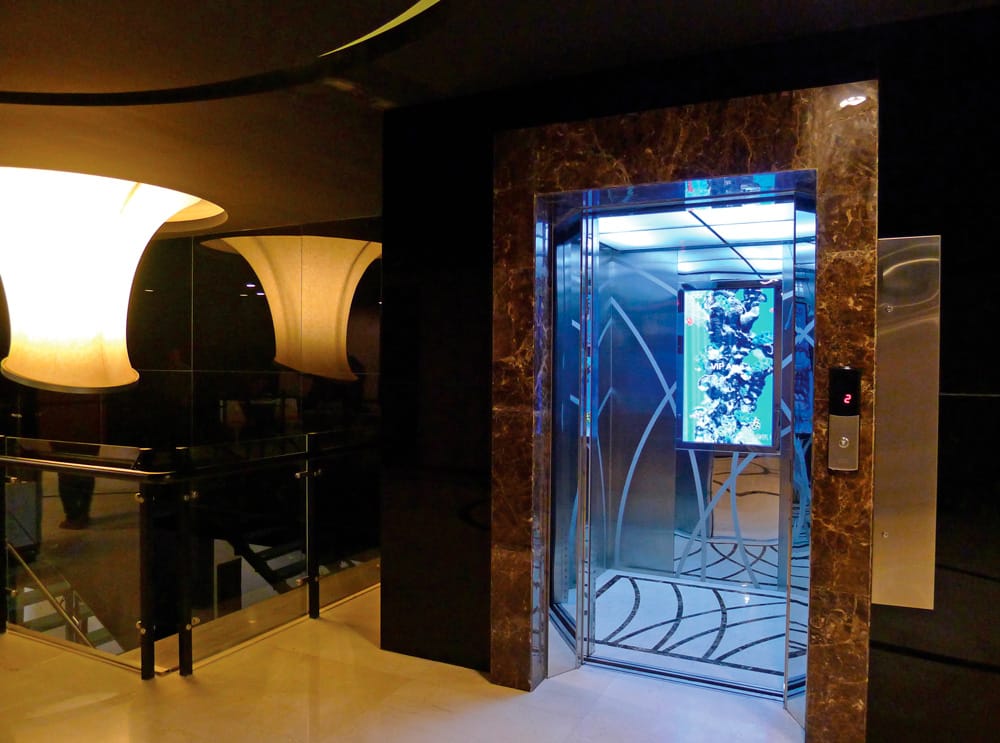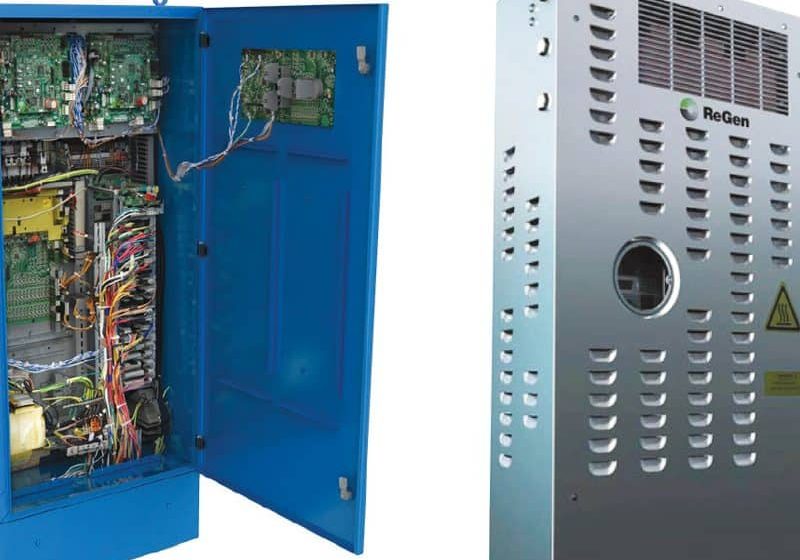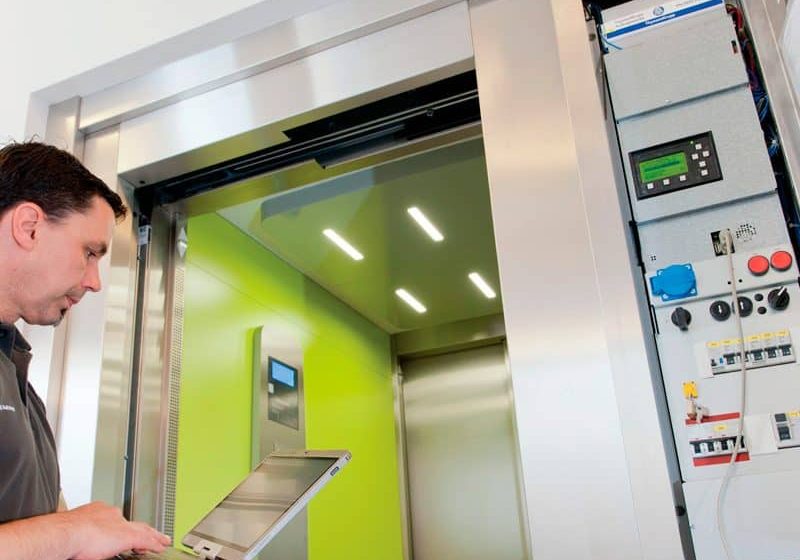Reimagining the Future of Vertical Transportation
Feb 1, 2014

DigiGage’s new products, partnership spur the realization of the company’s high ambitions.
Ever since the basic concept of a safe elevator was introduced by Elisha Graves Otis in 1854, we have witnessed great progress in elevator technology: smart doors, sophisticated traffic-management systems, machine-room-less and gearless solutions, all of which allow elevators to become a universal means of vertical transportation. More and more people can travel faster, safer and more comfortably thanks to the evolution of these technologies.
Our multibillion-U.S.-dollar industry of carrying billions of people around the world has facilitated the construction of megacities. Today’s elevator is a colossus made up of many moving parts with one purpose: to lift people from point A to point B in the fastest and most efficient way possible. There is, however, a downside: passengers are forced to travel in small enclosed cabs, aware they are moving but seeing nothing before them but gray space. They are often forced to endure awkward inactivity, avoid eye contact with fellow riders and stare at a light hoping it will soon indicate they have reached the next floor, all the while wondering impatiently, “Are we there yet?”
A Screen in Every Elevator
The evolution inside the cab is in its initial stage. In an era where the Internet, mobile phones and even cars prioritize user experience and design, the passenger experience in elevator cabs has not yet caught up. Current trends suggest that the appearance of screens inside elevator cabs is inevitable. Questions that remain are what will be shown on those screens and for what purpose.
All major elevator manufacturers offer screens embedded in their cabs, while aftermarket companies offer retrofitted tailored content – generalized clips, images or advertisements. But, the modern mass market demands more than screens and content; consumers need a turnkey solution capable of delivering engagement, with a universal content and management system that is easy to maintain and pleasing to watch. Of course, for broad acceptance, the system needs to be offered at an affordable price that could fit not only high-end, high-rise projects, but also mid-range, low-rise buildings.
Screens in elevators today are usually only seen in high-end buildings, often containing advertisements not suited to such locations as residential buildings. The screens that push advertisements can also be seen as cheap and intrusive, even in hotels and company-owned buildings. The dedicated content solutions are generally suited only to buildings with owners able to invest the management effort and budget it requires. The rest of the market needs something else to run on its screens: not just TV content, but easy-to-manage, affordable, enjoyable content specially designed to address the wellbeing of vertical-transportation passengers.
The Virtual Window
DigiGage’s solution is to turn any closed elevator cabin into a “digitally transparent” elevator. Designed to improve the user experience in elevators, the product is intended to redefine elevator architecture, allowing passengers to engage with their environment. Using DigiGage’s patent-pending winGage software (ELEVATOR WORLD, October 2012) provides a motion-based, digitally designed “elevator virtual window,” the company reports. It works completely independently of the elevator’s controller and is driven by a sensor that feels the elevator movements to determine the speed, height and current floor of the cab.
The system also has a variety of features that enable real-time information and engagement. All features are easily controlled by the building using a cloud-based control panel, which allows managers to remotely perform the following:
- Change the elevator virtual window view, choosing from a variety of scenic, urban, artistic or even humorous “content worlds”
- Post building messages
- Update floor-specific text, like family names of residents, or companies or departments on a floor, or even announce specific occasions relevant to a given floor at a certain time
- Select real-time news feeds
- Connect social-media “virtual walls” to the physical elevator wall
When a passenger steps into an elevator equipped with a DigiGage virtual window, he or she sees a colorful and dynamic scene through it. This is not a movie running in a loop, but an actual virtualization of a scene that is “living” in real time inside the computer. When the elevator begins to ascend, the viewpoint in that virtual world changes accordingly, synchronizing what the passenger is feeling to what he or she is seeing as if it were a real window. The cab travels in the shaft, and so does the point of view in the virtual world. If using the aquarium program, some of the fish will remain stationary in the scene, while the dolphins start to swim alongside the elevator cab, as if escorting the passenger. On the way down, when traveling below the ground floor, the view takes the passenger under a reef, to a darker place with glowing fish. Any Internet-connected device can access a secure website to update the display to space-travel, hot-air-balloon-flying and many other scenes.
Some content worlds also tell stories over time. For example, if building management chooses the Paris content world, the Eiffel Tower will be built in front of passengers’ eyes during a three-week period, as it transforms from a sketched black and white image to a modern and colorful one. Day and night cycles and seasons can also be chosen.
Where did these ideas originate? The two serial entrepreneurs and founders of DigiGage, President Ben Kidron and CEO Jonathan Einav, were in an elevator wondering why the user experience was comparatively so far behind other transportation experiences. According to Einav:
“We brainstormed possible ways to enhance the atmosphere and stimulate our senses when we are stuck there every single day. We fantasized about having a big window and looking out onto another place where the perspective of the view changes as we climb higher, so we see movement as we feel it. We quickly understood how potentially big this could be. We came to the obvious conclusion that it should be virtual and in real-time, so we could evolve the visual story, even letting users pick and choose between fantasies.”
But they also understood that to make a real change, the product needed to reach the mass market as an easy-to-digest, off-the-shelf item, as opposed to one tailored to the needs of only specific premium buildings.
Aspects of the System
Independence
In developing their product, Einav and Kidron realized they had to invent an autonomous system that uses an independent sensor to extract elevator-cab movement. They also developed algorithms to understand the sensor and reliably translate its readings to height, speed and floor indication for optimal on-screen performance. They decided to use an accelerometer and developed an algorithmic layer that, on installation, learns the shaft height, location of each stop, speed and acceleration patterns, and even the “noises” of a particular elevator. The system’s fast learning curve allows it to detect changes over time, emergency stops, servicing activities and other irregularities, all through a module that can send notifications and analytic data about the irregularity to an elevator/service company. The end result is with an independent, sensor-based system that does not require reference points in the shaft.
Ease of Use and Flexibility
To avoid imposing specific hardware and settings on their partners, Einav and Kidron designed the system to be easy to install and maintain, to the extent that existing elevator personnel can efficiently calibrate and configure the system, from the point of installation to regular daily use. To achieve this, they decided to go with off-the-shelf hardware purchased and maintained by the elevator companies, which can choose the brands of computer and screen, screen size, orientation, etc.
Realizing that a steady Internet connection in the shaft is often not available, the company founders set a prerequisite for the system to be completely independent. Their own communications software deals with disconnections, corrupted data and remote maintenance, and an updates system can still function without ideal Internet connectivity. The software had to be not only easy to install, maintain and manage, but also flexible and efficient. It had to support most screen types, orientations and computing units so elevator companies could customize their own virtual-window solutions to suit their models.
Content
Einav and Kidron set out to create an ever-growing content library directed to the greatest common denominator, from which a building would be able to choose its favorites and change them at a whim. They wanted their system to create a pure, relaxing and pleasing atmosphere, a reason they avoided adding advertisements or sound effects to the visuals. The movement of the content is intended to synchronize to what the user feels but does not require the user to actively control it.
After evaluating 30 different content types, selling and installing systems in hotels, hospitals, mid-end residential buildings, office buildings and brand-owned buildings over two years, DigiGage’s owners reviewed the way clients reacted to the system, as well as how they managed the content and received feedback. They also met with architects, elevator consultants, and elevator and building-management companies in this pilot period. Because they believe the power of the community is much stronger than the power of a single entity, by the end of 2014, they plan to release an open platform for third-party content creation, allowing artists to create engaging virtual windows that will be sold online on a revenue-sharing basis, much like Apple’s App Store or Google Play.
Social Elevator Cabs
During the pilot period prior to beginning global distribution, Einav and Kidron identified another need that was immediately implemented: a tool that makes the screen in the elevator the “wall” of an existing social-media network, such as Facebook. This latest is intended to help the building stay as up-to-date as possible, enabling all tenants to have direct access to the virtual window. Building group posts are shown jointly with profile pictures and names, giving public expression to tenants’ individual posts. This feature can be deactivated, open to all or set so each user would need the acceptance of the building administrator.
Perception
After examining reactions at sites where the virtual window had been installed for at least a year, Einav and Kidron found a marked improvement in passengers’ perception of ride quality, though no mechanical changes had been performed on the elevator. Passengers paid attention to the moving content, rather than any vibrations or noises present in a moving cab. They were surprised to receive many reports that compared equal-sized cabs, where the one with the virtual window felt bigger and its ride duration shorter, compared to the one without it. They also received reports of significant decline in passenger anxiety levels.
Redefining “B”
Taking people from points “A” to “B” is a vast task that occupies the best minds in this industry. The market demands more and more elevators, in lower prices and with constantly improving efficiency, such that this task has become the lone goal. The performance race of this goal has created a simple ride of two dimensions. DigiGage made it a goal to take people out of a “dry ride” and into an “experience ride,” exceeding their expectations by saying that “B” is not only a floor, but also a new state of mind.
DigiGage promotes exposing passengers to a pleasing view that responds to their senses. Coordinating the captive traveler’s senses promises a more relaxed and pleasing ride, and the cab’s transformation into the building information center can potentially revolutionize the passenger perception of the mundane elevator cab, opening an ocean of possibilities for the vertical-transportation industry.
Availability
DigiGage’s winGage systems can be purchased, either by elevator companies as software and sensors directly from DigiGage or as a complete solution from DigiGage partners. www.digigage.com
Get more of Elevator World. Sign up for our free e-newsletter.









